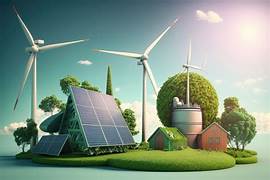Can Technological Advancements Lead to a Fully Renewable Energy-Dependent World?
As the global population grows and energy demands increase, the question of sustainable energy has become more urgent than ever. Fossil fuels, which have powered the industrial and technological advancements of the past two centuries, are finite and a significant contributor to climate change. In contrast, renewable energy sources such as solar, wind, hydro, and geothermal offer an inexhaustible supply of clean energy. But can technological advancements alone pave the way to a fully renewable energy-dependent world?
This article examines the potential of technology to revolutionize renewable energy production, storage, and distribution, explores the challenges that remain, and evaluates the path forward toward a sustainable future.
1. Current State of Renewable Energy
A. Increasing Adoption
Renewable energy has seen tremendous growth in recent decades. Solar and wind energy production costs have plummeted, making them competitive with fossil fuels in many regions. In 2023, renewables accounted for nearly 30% of global electricity generation, a significant leap from previous years.
B. Technological Contributions So Far
- Solar Panels: The efficiency of photovoltaic (PV) cells has improved dramatically, enabling greater energy capture even in areas with less sunlight.
- Wind Turbines: Modern wind turbines are taller, more efficient, and capable of harnessing wind energy even at low speeds.
- Energy Storage: Advances in battery technology, such as lithium-ion batteries, have enhanced the ability to store renewable energy for later use.
Despite these advancements, fossil fuels remain dominant, supplying about 70% of global energy needs. Transitioning entirely to renewable energy requires addressing technological, economic, and logistical hurdles.
2. Technological Innovations Driving the Renewable Energy Revolution
A. Enhancing Energy Generation
- Perovskite Solar Cells: Perovskite-based solar cells offer higher efficiency at lower costs compared to traditional silicon-based cells. Their flexibility and lightweight nature make them ideal for diverse applications.
- Floating Wind Farms: Offshore wind farms are expanding to areas previously deemed unsuitable, thanks to floating turbine technology. This innovation harnesses wind energy in deep waters, where wind speeds are higher and more consistent.
- Hydrogen Energy: Electrolysis, powered by renewable energy, is making green hydrogen production viable. Hydrogen can act as a clean fuel and energy storage medium, bridging gaps in renewable supply.
B. Advancing Energy Storage
- Solid-State Batteries: These next-generation batteries promise higher energy density, longer life spans, and faster charging times compared to lithium-ion batteries.
- Grid-Scale Storage: Technologies like flow batteries and gravity-based storage systems allow renewable energy to be stored on a large scale, ensuring consistent power supply.
- Thermal Storage: Innovations in thermal energy storage, such as molten salt systems, enable excess solar or wind energy to be stored as heat and converted back to electricity when needed.
C. Optimizing Energy Distribution
- Smart Grids: Integrating AI and IoT into energy grids creates “smart grids” that can balance supply and demand dynamically, prevent energy loss, and adapt to fluctuations in renewable energy generation.
- Microgrids: Decentralized energy systems, or microgrids, empower communities to produce and manage their energy independently, increasing resilience and reducing reliance on centralized grids.
3. Challenges to Achieving a Fully Renewable World
A. Intermittency Issues
Renewable energy sources like solar and wind are inherently intermittent, depending on weather and time of day. Even with advanced storage technologies, achieving a stable and reliable energy supply remains a challenge.
B. Infrastructure Limitations
- Many existing power grids are not designed to handle decentralized and variable energy inputs from renewables.
- Retrofitting or replacing infrastructure involves substantial costs and logistical challenges.
C. High Initial Investment
While renewable energy is cost-effective in the long run, the upfront investment in new technologies, infrastructure, and systems remains a barrier, especially for developing countries.
D. Rare Earth Material Dependency
Renewable technologies like wind turbines and batteries rely on rare earth materials such as lithium and cobalt. Mining these materials poses environmental and ethical concerns, creating a need for alternative solutions.
E. Political and Economic Factors
- Fossil fuel industries wield significant influence, often lobbying against renewable energy initiatives.
- Political will and global cooperation are essential to enact policies that promote renewables and phase out fossil fuels.
4. The Role of Policy and Global Collaboration
While technological advancements are critical, they alone cannot drive the transition to a fully renewable energy-dependent world. Policies and international cooperation are equally essential.
A. Subsidies and Incentives
Governments can accelerate renewable energy adoption by subsidizing technologies, offering tax breaks for clean energy projects, and imposing carbon taxes on fossil fuel consumption.
B. International Agreements
Global cooperation, as seen in the Paris Agreement, is necessary to set emissions targets and share technological innovations. Wealthier nations must also support developing countries in adopting renewable energy.
C. Education and Awareness
Raising public awareness about the benefits of renewable energy can drive grassroots support, leading to stronger demand and investment in clean energy solutions.
5. A Vision for the Future
A. Decentralized Energy Systems
The future of energy lies in decentralization. Rooftop solar panels, community wind projects, and microgrids can empower individuals and communities to generate and manage their energy.
B. Integration of Emerging Technologies
- Artificial Intelligence: AI can optimize energy generation, predict demand patterns, and enhance grid stability.
- Blockchain: Blockchain technology can facilitate peer-to-peer energy trading, enabling individuals to sell excess energy directly to others.
- Fusion Energy: Although still in its infancy, nuclear fusion holds the promise of providing nearly limitless, clean energy.
C. Circular Economy in Renewable Energy
Recycling and reusing materials from old solar panels, wind turbines, and batteries can address resource scarcity and reduce environmental impact.
D. Societal Transformation
The shift to renewable energy requires a cultural shift as much as a technological one. Sustainable lifestyles, reduced energy consumption, and responsible energy use are vital components of this transformation.
6. Technological Optimism: Is a Fully Renewable World Feasible?
Technological advancements have already demonstrated the potential to revolutionize renewable energy. Innovations in energy generation, storage, and distribution are addressing many of the challenges that once seemed insurmountable.
However, technology cannot operate in isolation. A fully renewable energy-dependent world requires a holistic approach involving policy reforms, public participation, and equitable access to resources. It also necessitates a shift in mindset—from prioritizing short-term gains to investing in long-term sustainability.
Conclusion
The transition to a fully renewable energy-dependent world is not just a technological challenge but a societal one. While significant hurdles remain, the advancements in renewable energy technologies offer hope for a sustainable future. By combining innovation with robust policies, global collaboration, and a commitment to sustainability, humanity can overcome the barriers and create an energy system that is clean, equitable, and resilient.
The dream of a renewable energy-dependent world is within reach. The question is not whether we can achieve it, but whether we have the collective will to make it a reality.


